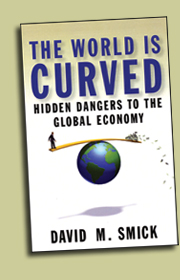 |
 |
 |
 |
|
|
Excerpts from The World Is Curved
From the Prologue: “It was not without enormous frustration that I approached writing a book about today’s new global economy. After all, what do we make of a world financial system that one minute appears to be performing beautifully, and the next acts as if the world is coming to an end? One minute the cybernetic (computer) revolution has transformed the economy into a veritable global wealth machine, as stock markets around the world soar to new highs. The next moment, markets plummet. People then read newspaper stories suggesting the value of their home may soon be less than their mortgage. They discover that their family’s life savings—even their cash left in supposedly ultrasafe money market funds—could soon go poof in the night. In trying to fully grasp the significance of the new global system,
I
began by rereading the seminal book on the subject of globalization,
Tom Friedman’s bestseller The World Is Flat: A Brief History
of the
Twenty-first Century. …” From Chapter One, “The End of the World”: “There is nothing quite like the potential for the world
economy’s
coming to an end to focus the mind and shake up a
quiet summer. It was the morning of August 10, 2007, and I
was chugging away on an exercise bike at the Westmoor Club on
Nantucket, a vacation island off the coast of Massachusetts. Improbably
piped overhead was Paul Simon singing ‘Slip Slidin’ Away.’ On
the wall, a soundless flat-screen television showed a gaggle of highcheeked
Victoria’s Secret underwear models strangely giggling as they
‘opened’ the New York Stock Exchange. The day before, the
Dow
Jones Industrial Average had crashed a whopping 387 points, nearly
3 percent. The previous night the Asian markets had plummeted, and
by morning European markets were sinking by an even greater magnitude.
The excited commentators on CNBC, the cable business
channel, had reached a state of apoplexy.
…”
|
| Copyright © 2008
David M. Smick All Rights Reserved. |